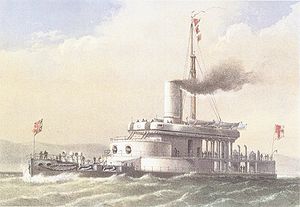
HMVS Cerberus is a breastwork monitor that served in the Victoria Naval Forces, the Commonwealth Naval Forces (CNF), and the Royal Australian Navy (RAN) between 1871 and 1924.
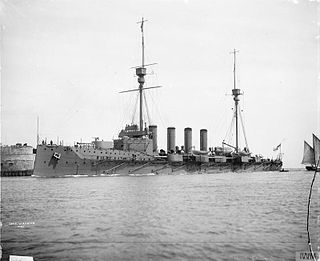
HMS Warrior was a Warrior-class armoured cruiser built for the Royal Navy in the first decade of the 20th century. She was stationed in the Mediterranean when the First World War began and participated in the pursuit of the German battlecruiser SMS Goeben and light cruiser SMS Breslau. Warrior was transferred to the Grand Fleet in December 1914 and remained there for the rest of her career. She was heavily damaged during the Battle of Jutland in 1916, after which she withdrew and was later abandoned and sank in a rising sea.

HMS Devastation was the first of two Devastation-class mastless turret ships built for the Royal Navy. This was the first class of ocean-going capital ship that did not carry sails, and the first whose entire main armament was mounted on top of the hull rather than inside it.
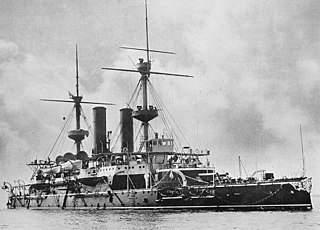
HMS Hood was a modified Royal Sovereign-class pre-dreadnought battleship built for the Royal Navy in the early 1890s. She differed from the other ships of the class in that she had cylindrical gun turrets instead of barbettes and a lower freeboard. She served most of her active career in the Mediterranean Sea, where her low freeboard was less of a disadvantage. The ship was placed in reserve in 1907 and later became the receiving ship at Queenstown, Ireland. Hood was used in the development of anti-torpedo bulges in 1913 and was scuttled in late 1914 to act as a blockship across the southern entrance of Portland Harbour after the start of World War I.
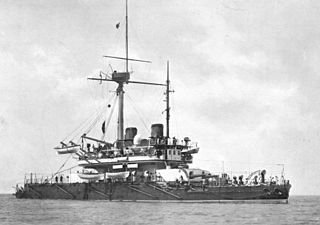
HMS Thunderer was one of two Devastation-class ironclad turret ships built for the Royal Navy in the 1870s. She suffered two serious accidents before the decade was out and gained a reputation as an unlucky ship for several years afterward. The ship was assigned to the Mediterranean Fleet in 1878 and was reduced to reserve in 1881 before being recommissioned in 1885. Thunderer returned home in 1887 and was again placed in reserve. She rejoined the Mediterranean Fleet in 1891, but was forced to return to the UK by boiler problems the following year. The ship became a coast guard ship in Wales in 1895 and was again placed in reserve in 1900. Thunderer was taken out of service in 1907 and sold for scrap in 1909.
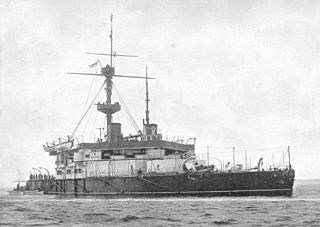
HMS Trafalgar was one of two Trafalgar-class battleships commissioned in 1890 and 1891, the other being HMS Nile. The ship was designed as an improved version of existing battleships with greater displacement and a thicker armoured belt amidships. Trafalgar saw active service as a battleship from 1890 to 1897 and from 1909 to 1911 when she was sold. Between these two periods as a combatant, Trafalgar served as a guardship and as a drill ship.

HMS Prince Albert was designed and built as a shallow-draught coast-defence ship, and was the first British warship designed to carry her main armament in turrets. The ship was named after Prince Albert, the late husband of Queen Victoria. At her wish, Prince Albert remained on the "active" list until 1899, a total of 33 years, by which time she had long ceased to be of any military value.

HMS Royal Sovereign was originally laid down as a 121-gun first-rate ship of the line of the Royal Navy. She would have mounted sixteen 8 in (200 mm) cannon, 114 32-pounder (15 kg) guns, and a 68-pounder (31 kg) pivot gun. With the rise of steam and screw propulsion, she was ordered to be converted on the stocks to a 131-gun screw ship, with conversion beginning on 25 January 1855. She was finally launched directly into the ordinary on 25 April 1857. She measured 3765 tons burthen, with a gundeck of 240 feet 6 inches (73.30 m) and breadth of 62 feet (19 m), and a crew of 1,100, with engines of 780 nhp.

The Cerberus-class breastwork monitor was a pair of breastwork monitors built for the Royal Navy in the 1860s.

HMS Magdala was a Cerberus-class breastwork monitor of the Royal Navy, built specifically to serve as a coastal defence ship for the harbour of Bombay in the late 1860s. She was ordered by the India Office for the Bombay Marine. The original specifications were thought to be too expensive and a cheaper design was ordered. While limited to harbour defence duties, the breastwork monitors were described by Admiral George Alexander Ballard as being like "full-armoured knights riding on donkeys, easy to avoid but bad to close with." Aside from gunnery practice Magdala remained in Bombay Harbour for her entire career. The ship was sold for scrap in 1903.

HMS Shannon was a Minotaur-class armoured cruiser built for the Royal Navy in the mid-1900s. Before the First World War, she served with the Home Fleet, generally as the flagship of a cruiser squadron. The ship remained with the Grand Fleet, as the Home Fleet was renamed when the war began, for the entire war, but only participated in a single battle, the Battle of Jutland in May 1916. Shannon spent most of the war unsuccessfully patrolling the North Sea for German warships and commerce raiders. She was paid off in 1919 and sold for scrap in 1922.

The Gorgon-class monitors were a class of monitors in service with the Royal Navy during World War I. Gorgon and her sister ship Glatton were originally built as coastal defence ships for the Royal Norwegian Navy, as HNoMS Nidaros and HNoMS Bjørgvin respectively but requisitioned for British use. Gorgon commissioned first, in June 1918 and bombarded German positions and other targets in Occupied Flanders. She fired the last shots of the war by the Royal Navy into Belgium on 15 October 1918. She was offered for sale after the war, but was used as a target ship when there were no takers. She was sold for scrap in 1928. Glatton was destroyed by a magazine explosion only days after she was completed in September 1918 while in Dover Harbour. She remained a hazard to shipping until the wreck was partially salvaged and the remains moved out of the way during 1925–26.

The Cyclops-class monitor was a group of four ironclad breastwork monitors built for the Royal Navy during the 1870s. They were slightly modified versions of the Cerberus-class monitors. The ships were ordered to satisfy demands for local defence during the war scare of 1870, but the pace of construction slowed tremendously as the perceived threat of war declined. The Cyclops-class monitors spent most of their careers in reserve and were finally sold off in 1903.

HMS Cyclops was the lead ship of the Cyclops-class breastwork monitors built for the Royal Navy during the 1870s. The ships were ordered to satisfy demands for local defence during the war scare of 1870, but the pace of construction slowed tremendously as the perceived threat of war declined. The ship spent most of her career in reserve; her only sustained period in commission was four months in Portland Harbour, during the Russo-Turkish War in 1878 when the British were trying to force the Russians to end the war without allowing them to seize Constantinople. Cyclops was sold for scrap in 1903.

HMS Gorgon was the first ship commissioned of the four Cyclops-class breastwork monitors built for the Royal Navy during the 1870s.

HMS Hecate was the last ship completed of the four Cyclops-class breastwork monitors built for the Royal Navy during the 1870s.

HMS Hydra was the second ship completed of the four Cyclops-class breastwork monitors built for the Royal Navy during the 1870s. The ships were ordered to satisfy demands for local defence during the war scare of 1870, but the pace of construction slowed tremendously as the perceived threat of war declined. The ship spent most of her career in reserve; her only sustained period in commission was four months during the Russo-Turkish War in 1878 when the British were trying to force the Russians to end the war without seizing Constantinople. Hydra was sold for scrap in 1903.

The two British Devastation-class battleships of the 1870s, HMS Devastation and HMS Thunderer, were the first class of ocean-going capital ship that did not carry sails, and the first which mounted the entire main armament on top of the hull rather than inside it.

Tempête was the lead ship for her class of two ironclad coast-defense ships built for the French Navy in the 1870s. Even though the ship was not fully commissioned until 1883, she played a minor role in the French occupation of Tunisia in 1881. Tempête accidentally sank a torpedo boat during night maneuvers in 1892 and was placed in reserve later that year. She became the flagship of the local defenses in French Tunisia in 1897 and was decommissioned in 1907. The ironclad served as a target ship for the next several years until she was sunk in 1909. Her wreck was salvaged beginning in 1912, but it was not completed until 1959.
